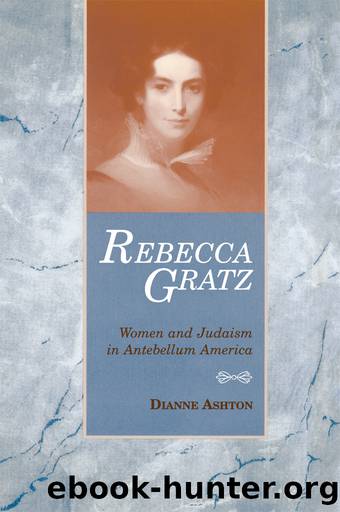Rebecca Gratz by Ashton Dianne;

Author:Ashton, Dianne; [Ashton, Dianne]
Language: eng
Format: epub
Publisher: Wayne State University Press
Published: 1997-08-15T00:00:00+00:00
Crossing Gender Roles through Piety
Gratz and the HSS managers created a curriculum that emphasized womenâs importance in Judaism by drawing on many resources. Leeser preached that women must have a religious education to qualify them for the âholy . . . [and] noble task . . . [of] sooth[ing], calm[ing]) and . . . render[ing] happy the rugged career of a father, a brother, a husband, or a child.â61 His approval must have been crucial to winning the support of the many Ashkenazic (northern European) Jews, by far the majority, who were accustomed to a religious community that was, at least among its religious leadership, highly differentiated by gender, because among these Jews, female prayer leaders commonly led women in synagogue worship.62 In addition to his theological supervision of the textbooks, his concern for promoting fledgling Jewish religious institutions and cultural resources, and the influence on him of strong women leaders such as Aguilar, Gratz, and the Peixotto sisters, Leeser also perceived Jewish standards for piety in a way that was nearly identical with those of Victorian culture.
Despite the HSS foundersâ personal objections to Reform, books by reformers of one stripe or another found their way into the schoolâs library, probably because so few English-language materials existed, and the library grew into an eclectic mix of approaches to Judaism. Several nineteenth-century Reform leaders claimed a commitment to âsecuring perfect equality between woman and man before God,â although women were not ordained until 1972.63 Samuel Pikeâs 1801 Hebrew Lexicon was joined by Rev. Dr. Leo Merzbacherâs 1855 prayer book, the first American Reform liturgy compiled by a rabbi and used in New Yorkâs Reform Temple Emanu El.64 An 1838 travelogue describing life in Syria was joined by an 1860 anonymous work, Thoughts Suggested by Bible Texts, and later by British Rev. Abraham P. Mendesâs 1870 catechism, The Law of Moses.65 As late as the 1870s, the more traditional HSS used the Hebrew Sabbath School Visitor, a childrenâs magazine published in Cincinnati by Reform rabbi Max Lilienthal, as a pedagogical aid. Although the Philadelphiansâ contract with Lilienthal originally stipulated that they would be able to return free of charge any issues they found offensive, they renewed their subscription yearly.66
One regular column in the Visitor was âLittle Nellieâs Catechism.â It described the efforts of Nellie, a Jewish Sunday school student, to train her younger brother and sister in Judaism by repeating to them the lessons she had learned in school. Nellieâs mother listened appreciatively to her children while wishing that she herself could have attended such a school. Nellieâs father was usually out of town on business. Stories in which daughters led their families in religious worship and education appeared more and more in popular literature, both Christian and Jewish, in the second half of the century. Just as in the antebellum era a motherâs religious leadership was made plausible through nursing and educating her own children, the Sunday school movement that swept across the country made it plausible that both male and female children might instruct their parents on religious matters.
Download
This site does not store any files on its server. We only index and link to content provided by other sites. Please contact the content providers to delete copyright contents if any and email us, we'll remove relevant links or contents immediately.
| Haggadah | Hasidism |
| History | Holidays |
| Jewish Life | Kabbalah & Mysticism |
| Law | Movements |
| Prayerbooks | Sacred Writings |
| Sermons | Theology |
| Women & Judaism |
The Secret Power of Speaking God's Word by Joyce Meyer(2750)
Man's Search for Meaning by Viktor E. Frankl(2555)
Mckeown, Greg - Essentialism: The Disciplined Pursuit of Less by Mckeown Greg(2332)
MOSES THE EGYPTIAN by Jan Assmann(2275)
Devil, The by Almond Philip C(2203)
Unbound by Arlene Stein(2179)
The Complete Dead Sea Scrolls in English (7th Edition) (Penguin Classics) by Geza Vermes(2135)
I Capture the Castle by Dodie Smith(1905)
Schindler's Ark by Thomas Keneally(1759)
The Invisible Wall by Harry Bernstein(1706)
The Gnostic Gospel of St. Thomas by Tau Malachi(1677)
The Bible Doesn't Say That by Dr. Joel M. Hoffman(1608)
The Secret Doctrine of the Kabbalah by Leonora Leet(1526)
Political Theology by Carl Schmitt(1500)
The Jewish State by Theodor Herzl(1469)
A History of the Jews by Max I. Dimont(1439)
The Dead Sea Scrolls Bible by Martin G. Abegg(1425)
The Book of Separation by Tova Mirvis(1419)
Oy!: The Ultimate Book of Jewish Jokes by David Minkoff(1293)
